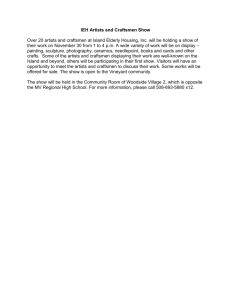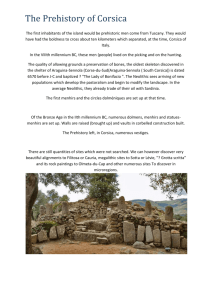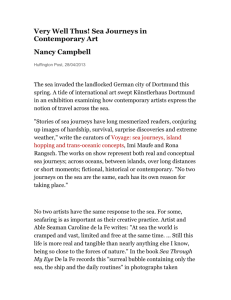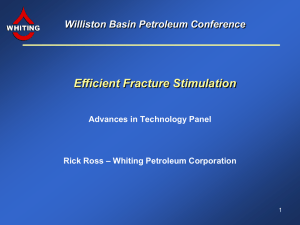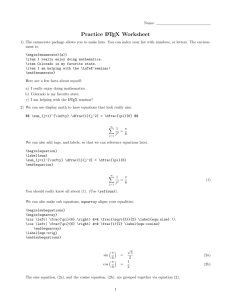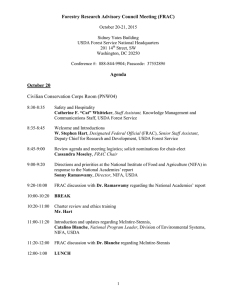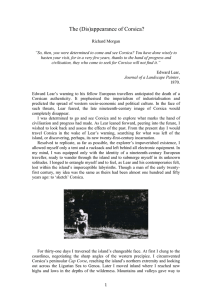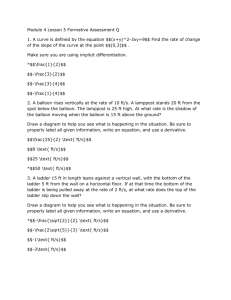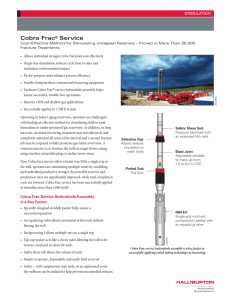Il MAN - Ubermorgen
advertisement
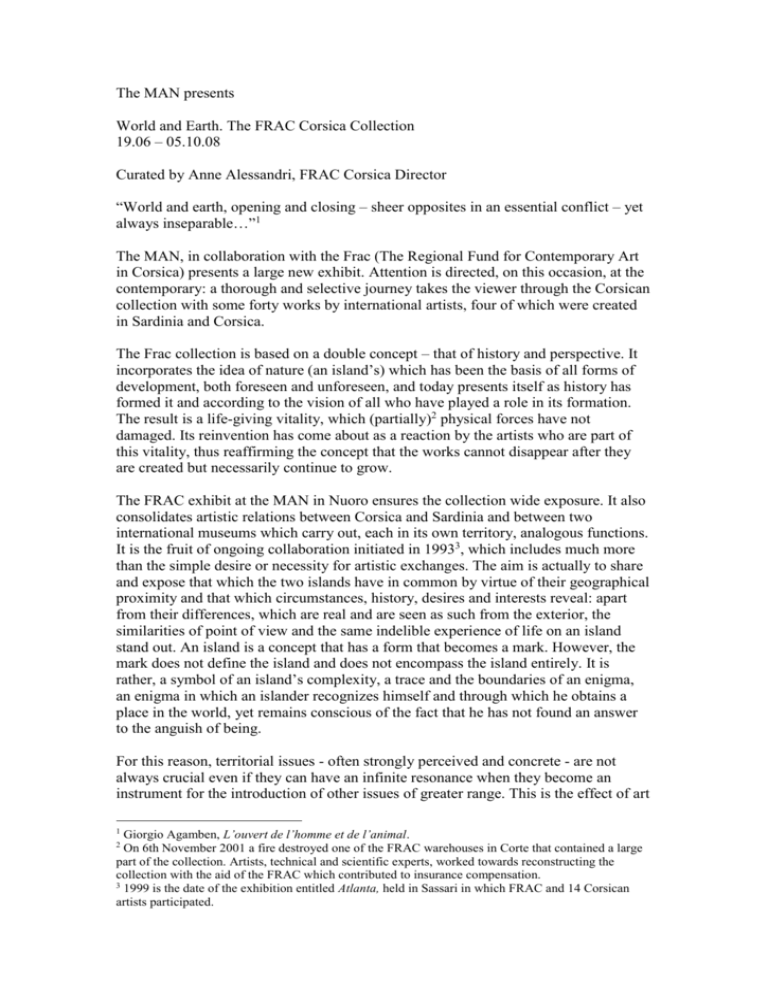
The MAN presents World and Earth. The FRAC Corsica Collection 19.06 – 05.10.08 Curated by Anne Alessandri, FRAC Corsica Director “World and earth, opening and closing – sheer opposites in an essential conflict – yet always inseparable…”1 The MAN, in collaboration with the Frac (The Regional Fund for Contemporary Art in Corsica) presents a large new exhibit. Attention is directed, on this occasion, at the contemporary: a thorough and selective journey takes the viewer through the Corsican collection with some forty works by international artists, four of which were created in Sardinia and Corsica. The Frac collection is based on a double concept – that of history and perspective. It incorporates the idea of nature (an island’s) which has been the basis of all forms of development, both foreseen and unforeseen, and today presents itself as history has formed it and according to the vision of all who have played a role in its formation. The result is a life-giving vitality, which (partially)2 physical forces have not damaged. Its reinvention has come about as a reaction by the artists who are part of this vitality, thus reaffirming the concept that the works cannot disappear after they are created but necessarily continue to grow. The FRAC exhibit at the MAN in Nuoro ensures the collection wide exposure. It also consolidates artistic relations between Corsica and Sardinia and between two international museums which carry out, each in its own territory, analogous functions. It is the fruit of ongoing collaboration initiated in 19933, which includes much more than the simple desire or necessity for artistic exchanges. The aim is actually to share and expose that which the two islands have in common by virtue of their geographical proximity and that which circumstances, history, desires and interests reveal: apart from their differences, which are real and are seen as such from the exterior, the similarities of point of view and the same indelible experience of life on an island stand out. An island is a concept that has a form that becomes a mark. However, the mark does not define the island and does not encompass the island entirely. It is rather, a symbol of an island’s complexity, a trace and the boundaries of an enigma, an enigma in which an islander recognizes himself and through which he obtains a place in the world, yet remains conscious of the fact that he has not found an answer to the anguish of being. For this reason, territorial issues - often strongly perceived and concrete - are not always crucial even if they can have an infinite resonance when they become an instrument for the introduction of other issues of greater range. This is the effect of art Giorgio Agamben, L’ouvert de l’homme et de l’animal. On 6th November 2001 a fire destroyed one of the FRAC warehouses in Corte that contained a large part of the collection. Artists, technical and scientific experts, worked towards reconstructing the collection with the aid of the FRAC which contributed to insurance compensation. 3 1999 is the date of the exhibition entitled Atlanta, held in Sassari in which FRAC and 14 Corsican artists participated. 1 2 works whose “proximity transports us to a place different from the one we usually inhabit”4, to use the words of Heidegger. This “elsewhere”, this “other” place is not clearly defined; it is vast, indescribable, and different but at the same time linked to our experience and thoughts (at times unexpressed). When explicit references to space, form and precise facts come together they are not isolated in one reality, but open the particular to the universal. This is the original idea of the exhibit which also takes into account the insular context in which the duality of “world/earth” is developed conceptually and materially. The exhibit World and Earth brings together works that are equally open to the exterior: other geographic or intellectual areas; discovered, invented or composed landscapes; new perceptions of the world and space. The artists propose experiences to be shared and raise environmental issues. Far from being commonplace, they create spaces for discussion, elements that lead to an awareness of reality and of possible universes; actions and positions that reveal the connections that exist between art and society, history and culture. Through a rough, strange and poetic language and without imposing morals or models, these artists awaken a critical sense of a dangerous drowsiness: in the dialogue that is initiated among them, and between them and the exterior, the works produce energy shared with the visitor. Artists present in the exhibit: Martine Aballea (France), Agnès Accorsi (France), Denis Adams (USA), Saâdane Afif (France), Eleanor Antin (USA), Johanna Billing (Sweden), Leonardo Boscani (Italy), Daniel Buren (France), Jean-Marc Bustamante (France), Jordi Colomer (Spain), Elie Cristiani (France), François Curlet (France), Dominique Degli Esposti (France), Anne Deleporte (France), Hakima El Djoudi (France), Simonetta Fadda (Italy), Malachi Farrell (France), Alicia Framis (Spain), Liam Gillick (Great Britain), Dominique Gonzalez-Foerster (France), Dan Graham (USA), Fabrice Hyber (France), Claire-Jeanne Jezequel (France), Valérie Jouve (France), Joseph Kosuth (USA), Ange Leccia (France), Pinuccia Marras (Italy), Antonio Muntadas (Spain), Marylène Negro (France), João Onofre (Spain), Gabriel Orozco (Mexico), June Bum Park (Corea), Gaël Peltier (France), Michelangelo Pistoletto (Italy), Wilfredo Prieto (Cuba), David Raffini (France), Navin Rawanchaikul (Thailand), Hugues Reip (France), Sigurdur Arni Sigurdsson (Iceland), Jana Sterbak (Canada/Czech Republic ), Laurent Tixador e Abraham Poincheval (France), Joséphine Sassu (Italy), Philippe Thomas (France), Barthélemy Toguo (Cameroon), James Turrell (USA), Jacques Villegle (France), Jeff Wall (Canada), Stephen Willats (Great Britain). 4 Martin Heidegger, L’origine de l’œuvre d’art.

